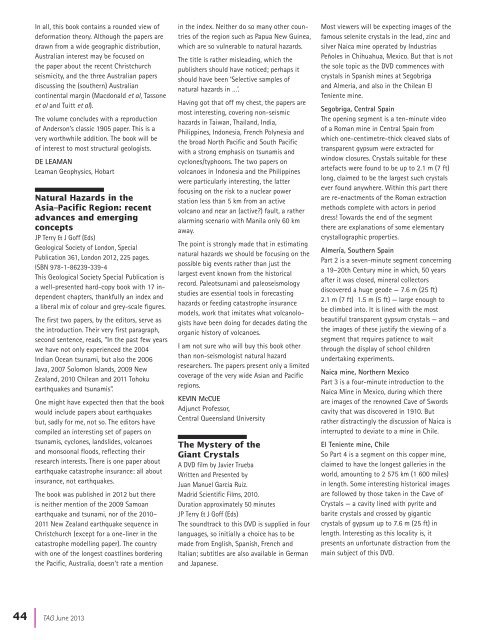TAG 167WEB
TAG 167WEB
TAG 167WEB
Create successful ePaper yourself
Turn your PDF publications into a flip-book with our unique Google optimized e-Paper software.
In all, this book contains a rounded view ofdeformation theory. Although the papers aredrawn from a wide geographic distribution,Australian interest may be focused onthe paper about the recent Christchurchseismicity, and the three Australian papersdiscussing the (southern) Australiancontinental margin (Macdonald et al, Tassoneet al and Tuitt et al).The volume concludes with a reproductionof Anderson’s classic 1905 paper. This is avery worthwhile addition. The book will beof interest to most structural geologists.DE LEAMANLeaman Geophysics, HobartNatural Hazards in theAsia–Pacific Region: recentadvances and emergingconceptsJP Terry & J Goff (Eds)Geological Society of London, SpecialPublication 361, London 2012, 225 pages.ISBN 978-1-86239-339-4This Geological Society Special Publication isa well-presented hard-copy book with 17 independentchapters, thankfully an index anda liberal mix of colour and grey-scale figures.The first two papers, by the editors, serve asthe introduction. Their very first paragraph,second sentence, reads, “In the past few yearswe have not only experienced the 2004Indian Ocean tsunami, but also the 2006Java, 2007 Solomon Islands, 2009 NewZealand, 2010 Chilean and 2011 Tohokuearthquakes and tsunamis”.One might have expected then that the bookwould include papers about earthquakesbut, sadly for me, not so. The editors havecompiled an interesting set of papers ontsunamis, cyclones, landslides, volcanoesand monsoonal floods, reflecting theirresearch interests. There is one paper aboutearthquake catastrophe insurance: all aboutinsurance, not earthquakes.The book was published in 2012 but thereis neither mention of the 2009 Samoanearthquake and tsunami, nor of the 2010–2011 New Zealand earthquake sequence inChristchurch (except for a one-liner in thecatastrophe modelling paper). The countrywith one of the longest coastlines borderingthe Pacific, Australia, doesn’t rate a mentionin the index. Neither do so many other countriesof the region such as Papua New Guinea,which are so vulnerable to natural hazards.The title is rather misleading, which thepublishers should have noticed; perhaps itshould have been ‘Selective samples ofnatural hazards in …’.Having got that off my chest, the papers aremost interesting, covering non-seismichazards in Taiwan, Thailand, India,Philippines, Indonesia, French Polynesia andthe broad North Pacific and South Pacificwith a strong emphasis on tsunamis andcyclones/typhoons. The two papers onvolcanoes in Indonesia and the Philippineswere particularly interesting, the latterfocusing on the risk to a nuclear powerstation less than 5 km from an activevolcano and near an (active?) fault, a ratheralarming scenario with Manila only 60 kmaway.The point is strongly made that in estimatingnatural hazards we should be focusing on thepossible big events rather than just thelargest event known from the historicalrecord. Paleotsunami and paleoseismologystudies are essential tools in forecastinghazards or feeding catastrophe insurancemodels, work that imitates what volcanologistshave been doing for decades dating theorganic history of volcanoes.I am not sure who will buy this book otherthan non-seismologist natural hazardresearchers. The papers present only a limitedcoverage of the very wide Asian and Pacificregions.KEVIN McCUEAdjunct Professor,Central Queensland UniversityThe Mystery of theGiant CrystalsA DVD film by Javier TruebaWritten and Presented byJuan Manuel Garcia Ruiz.Madrid Scientific Films, 2010.Duration approximately 50 minutesJP Terry & J Goff (Eds)The soundtrack to this DVD is supplied in fourlanguages, so initially a choice has to bemade from English, Spanish, French andItalian; subtitles are also available in Germanand Japanese.Most viewers will be expecting images of thefamous selenite crystals in the lead, zinc andsilver Naica mine operated by IndustriasPeñoles in Chihuahua, Mexico. But that is notthe sole topic as the DVD commences withcrystals in Spanish mines at Segobrigaand Almeria, and also in the Chilean ElTeniente mine.Segobriga, Central SpainThe opening segment is a ten-minute videoof a Roman mine in Central Spain fromwhich one-centimetre-thick cleaved slabs oftransparent gypsum were extracted forwindow closures. Crystals suitable for theseartefacts were found to be up to 2.1 m (7 ft)long, claimed to be the largest such crystalsever found anywhere. Within this part thereare re-enactments of the Roman extractionmethods complete with actors in perioddress! Towards the end of the segmentthere are explanations of some elementarycrystallographic properties.Almería, Southern SpainPart 2 is a seven-minute segment concerninga 19–20th Century mine in which, 50 yearsafter it was closed, mineral collectorsdiscovered a huge geode — 7.6 m (25 ft)2.1 m (7 ft) 1.5 m (5 ft) — large enough tobe climbed into. It is lined with the mostbeautiful transparent gypsum crystals — andthe images of these justify the viewing of asegment that requires patience to waitthrough the display of school childrenundertaking experiments.Naica mine, Northern MexicoPart 3 is a four-minute introduction to theNaica Mine in Mexico, during which thereare images of the renowned Cave of Swordscavity that was discovered in 1910. Butrather distractingly the discussion of Naica isinterrupted to deviate to a mine in Chile.El Teniente mine, ChileSo Part 4 is a segment on this copper mine,claimed to have the longest galleries in theworld, amounting to 2 575 km (1 600 miles)in length. Some interesting historical imagesare followed by those taken in the Cave ofCrystals — a cavity lined with pyrite andbarite crystals and crossed by giganticcrystals of gypsum up to 7.6 m (25 ft) inlength. Interesting as this locality is, itpresents an unfortunate distraction from themain subject of this DVD.44 |<strong>TAG</strong> June 2013


